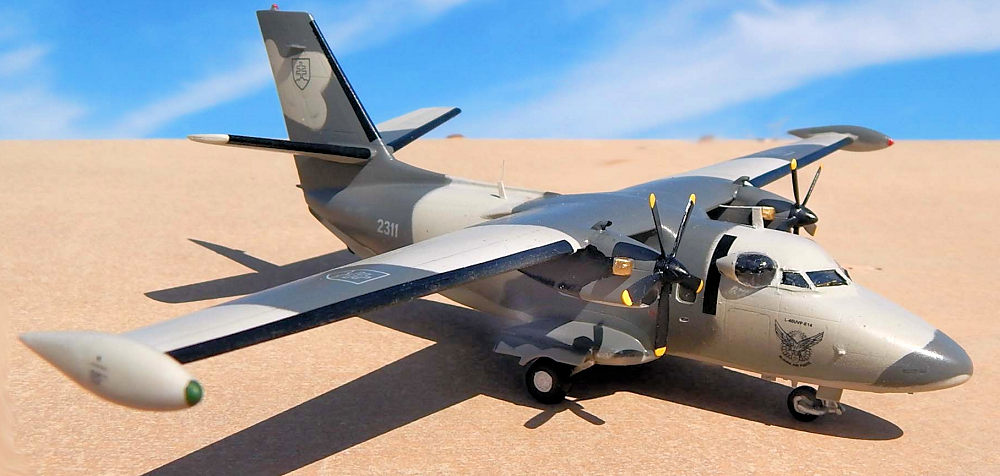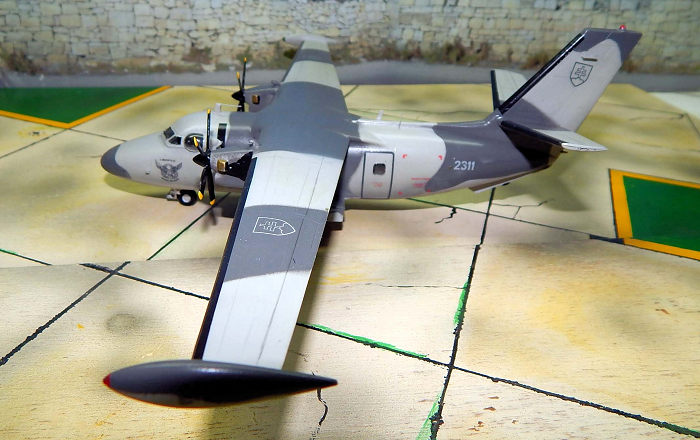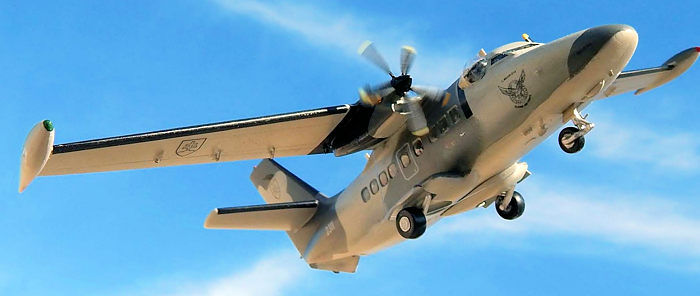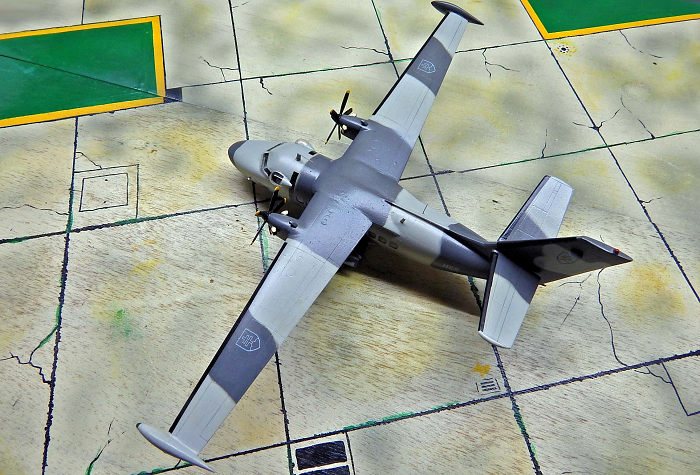
| KIT #: | 0 |
| PRICE: | 12 Euros |
| DECALS: | Three options |
| REVIEWER: | Carmel J. Attard |
| NOTES: | Short run with photo etch and resin parts |

| HISTORY |
Originating in 1936 the Let Company is the largest manufacturer of commuter aircraft and gliders. Since 1953 it produced C11 trainers, LF109, LG124, L13 Blanik, and L-23, L-33, Aero45 L-200 Morova, Z37 agricultural aircraft, L-29 jet trainers, L-410 andL-610.
 The L-410
commuter aircraft flew in prototype form in spring 1969 and was later produced
in a number of versions. The first 32 units had PTBA-27 engines; and all of the
rest L-4210 are powered by Czech made Walter M-601 engines. The most numerous
version is L-410 UVP of which over 500 units were manufactured and almost 400
units of L-410 VVP-E version. The latter with 17-19 seat passenger version, or
other operations as cargo, ambulance, VIP, photogrammetric and paratroops
versions.
The L-410
commuter aircraft flew in prototype form in spring 1969 and was later produced
in a number of versions. The first 32 units had PTBA-27 engines; and all of the
rest L-4210 are powered by Czech made Walter M-601 engines. The most numerous
version is L-410 UVP of which over 500 units were manufactured and almost 400
units of L-410 VVP-E version. The latter with 17-19 seat passenger version, or
other operations as cargo, ambulance, VIP, photogrammetric and paratroops
versions.
Over 1,000 units of all L-410 varieties were delivered to various customers mainly in the continent of Africa, South and Central America, India, Philippines and CIS. Recent air forces that make use of of the L-410 are Czech AF, with L-410T, Slovak AF has L-410 UVP-E, Slovenia AF with L-410 UVP-E and Tunisia also with a similar version. The L-410 can operate consistently on unpaved runways and in severe climatic conditions.
| THE KIT |
 Moulded in
light grey styrene, the kit consists of 58 parts, 2 vac cockpit windscreens (one
being spare), 3 side observation blisters and a number of cabin windows
including a few spare ones. The kit essentially contains four major assembly
stages. These are assembly of a detailed crew and passenger cabin compartments
that includes two crew seats, control wheels, instrument panel, and for the
cabin there is a full seating arrangement to add to one’s taste. There are roof
neon lighting panels and front and rear bulkheads. The completed assembly is
then inserted between the two fuselage halves. Other stages are those of main
and tail wings, engines and undercarriage. There is a choice of five or three
bladed propellers to go with any one of the three operators provided in decal
form. Two civil ones include an Aeroflot and one military camouflaged in Dark
green and brown green operated by Czech AF.
Moulded in
light grey styrene, the kit consists of 58 parts, 2 vac cockpit windscreens (one
being spare), 3 side observation blisters and a number of cabin windows
including a few spare ones. The kit essentially contains four major assembly
stages. These are assembly of a detailed crew and passenger cabin compartments
that includes two crew seats, control wheels, instrument panel, and for the
cabin there is a full seating arrangement to add to one’s taste. There are roof
neon lighting panels and front and rear bulkheads. The completed assembly is
then inserted between the two fuselage halves. Other stages are those of main
and tail wings, engines and undercarriage. There is a choice of five or three
bladed propellers to go with any one of the three operators provided in decal
form. Two civil ones include an Aeroflot and one military camouflaged in Dark
green and brown green operated by Czech AF.
| CONSTRUCTION |
 Following a
thorough study of the kit instructions the assembly is a straightforward one. A
small issue is the need to sand down the corners of the two fuselage bulkheads,
which makes part of a complete interior assembly before this is inserted between
the fuselage halves. Weight is also added to nose empty space, as the model
needs to rest on the nose wheel. Extra care was needed when cutting the
windscreen and the two cockpit side blisters. The passenger windows although
these are vac form these made good fit. The Slovak machine required the five
bladed propellers to fit to the engines. I also added a crew figure, as this is
not supplied with the kit even though this is barely visible from outside.
Following a
thorough study of the kit instructions the assembly is a straightforward one. A
small issue is the need to sand down the corners of the two fuselage bulkheads,
which makes part of a complete interior assembly before this is inserted between
the fuselage halves. Weight is also added to nose empty space, as the model
needs to rest on the nose wheel. Extra care was needed when cutting the
windscreen and the two cockpit side blisters. The passenger windows although
these are vac form these made good fit. The Slovak machine required the five
bladed propellers to fit to the engines. I also added a crew figure, as this is
not supplied with the kit even though this is barely visible from outside.
| COLORS & MARKINGS |
All interior is light grey and seats are custom painted. Instead of using kit decals I made use of decal sheet AZ7032 that I got from Hannants recently. This sheet has four options, a Czech, Slovak, Slovenian and a Tunisian AF machine and my pick went to the Slovak AF Let-410 UVP-E, which also had a 5-bladed propeller. This is finished in a two-tone grey upper camouflage and light grey undersides.
| CONCLUSIONS |
The end result is a pleasing L-410 completed into a more recent livery. The type also happened to land here at Luqa airfield as also did the Tunisian AF Turbolet. I recommend the model to those keen on adding latest types of military aircraft in service.
1 May 2018
Copyright ModelingMadness.com
Thanks to me for picking this one up when it was on sale.
If you would like your product reviewed fairly and quickly, please contact the editor or see other details in the Note to Contributors.